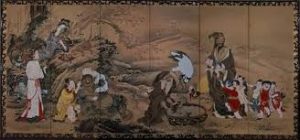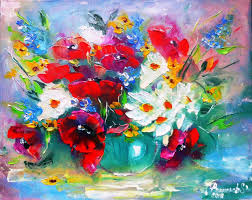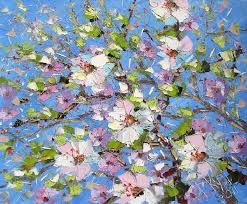LENINGRAD SCHOOL OF PAINTING (part 1)
 The history of the Leningrad school of painting covers the period from the beginning of the 1930s to the beginning of the 1990s. Having arisen in the midst of a heated struggle over the development of art and art education in the USSR, it became that missing link, thanks to which the traditions of the national art school and realistic painting were preserved and received a new development.
The history of the Leningrad school of painting covers the period from the beginning of the 1930s to the beginning of the 1990s. Having arisen in the midst of a heated struggle over the development of art and art education in the USSR, it became that missing link, thanks to which the traditions of the national art school and realistic painting were preserved and received a new development.
Having made a significant contribution to Soviet fine art, to the formation of aesthetic views and the spiritual world of modern generations, the Leningrad school left the stage at the turn of the 80-90s, fulfilling its historical and artistic mission and giving way to the era of the transitional period. Continue reading
VLADIMIR SCHOOL SCHOOL SCHOOL (part 2)
 By the 1970s, the recognizable style of painting, common to all representatives of the Vladimir school, was finally formed. The landscape space in them, as a rule, is reduced to a plane. The plans are brought together, the composition is extremely simple, the horizon line in the paintings is deliberately overestimated. This set of techniques gives reason to talk about the closeness of their aesthetics with the stylistic principles of Rostov-Suzdal icon painting … The letter in Vladimir painting is temperamental, the texture is particularly striking. A completely unique find of Vladimirites is the use of experimental bulk soils that enhance the decorative effect of textured writing. Bright, pasty painting on the textured soil, different heights of the colorful relief in the picture increased the living trepidation of the depicted, enhanced the contrast of the color scheme. Continue reading
By the 1970s, the recognizable style of painting, common to all representatives of the Vladimir school, was finally formed. The landscape space in them, as a rule, is reduced to a plane. The plans are brought together, the composition is extremely simple, the horizon line in the paintings is deliberately overestimated. This set of techniques gives reason to talk about the closeness of their aesthetics with the stylistic principles of Rostov-Suzdal icon painting … The letter in Vladimir painting is temperamental, the texture is particularly striking. A completely unique find of Vladimirites is the use of experimental bulk soils that enhance the decorative effect of textured writing. Bright, pasty painting on the textured soil, different heights of the colorful relief in the picture increased the living trepidation of the depicted, enhanced the contrast of the color scheme. Continue reading
VLADIMIR SCHOOL SCHOOL SCHOOL (part 1)
 Vladimir landscape painting is a trend that firmly established itself in art in the 1970s and is now included in the treasury of genuine achievements of the Russian national school. For the first time, artists of this region made themselves known after the First Republican Exhibition “Soviet Russia” held in Moscow in 1960, when three artists – Kim Britov, Vladimir Yukin and Valery Kokurin – showed their works, the result of creative searches and experiments.
Vladimir landscape painting is a trend that firmly established itself in art in the 1970s and is now included in the treasury of genuine achievements of the Russian national school. For the first time, artists of this region made themselves known after the First Republican Exhibition “Soviet Russia” held in Moscow in 1960, when three artists – Kim Britov, Vladimir Yukin and Valery Kokurin – showed their works, the result of creative searches and experiments.
In his works, K. Britov frantically studied the techniques of textured writing, looking for a special luminiferous color that conveys the mood. V. Yukin sought to express feelings through the state of nature, V. Kokurin was interested in a light-air environment that changes color and shape of objects. Continue reading
VITEBSK ART SCHOOL (part 3)
 The circle of sources covering this time in the biography of the master is mainly identified and studied, therefore all sorts of new information and facts are so rare and valuable. Vitebsk teacher Valentin Karlovich Seilert in the late 1910s visited Pan, and in 1920-1922. studied in Witsvomas with K. Malevich. In his memoirs, he cites an interesting episode dating back to 1919. “Once I once came to Yuri Moiseevich. He had none of his students at that time. I went straight to him in his personal little workshop. I went there, and there they sat on the sofa, Yuri Moiseevich sat, and there was Chagall. Chagall in the corner near the window set his canvas. And then they sat, therefore, and discussed, because Chagall listened to Pan’s opinion, just like a diligent student, with respect to his teacher. But despite this, he, of course, continued his line of behavior. Continue reading
The circle of sources covering this time in the biography of the master is mainly identified and studied, therefore all sorts of new information and facts are so rare and valuable. Vitebsk teacher Valentin Karlovich Seilert in the late 1910s visited Pan, and in 1920-1922. studied in Witsvomas with K. Malevich. In his memoirs, he cites an interesting episode dating back to 1919. “Once I once came to Yuri Moiseevich. He had none of his students at that time. I went straight to him in his personal little workshop. I went there, and there they sat on the sofa, Yuri Moiseevich sat, and there was Chagall. Chagall in the corner near the window set his canvas. And then they sat, therefore, and discussed, because Chagall listened to Pan’s opinion, just like a diligent student, with respect to his teacher. But despite this, he, of course, continued his line of behavior. Continue reading
VITEBSK ART SCHOOL (part 2)
 Having learned the lessons of new European art and declaring himself to be a rapidly maturing master, M. Chagall returned to Vitebsk on the eve of the First World War. In fact, in less than a decade, from an unknown student of a provincial artist, he grows into one of the leading masters of the emerging avant-garde. And this is not surprising if you pay attention to how easily and organically he created his original art system, attracting childishly naive imagination and romantic metaphor, intrepidly departing from realism and ahead of the masters of Western Europe, whose evolution indicates the intense efforts made to free oneself from the tenacious embrace of the artistic tradition. Continue reading
Having learned the lessons of new European art and declaring himself to be a rapidly maturing master, M. Chagall returned to Vitebsk on the eve of the First World War. In fact, in less than a decade, from an unknown student of a provincial artist, he grows into one of the leading masters of the emerging avant-garde. And this is not surprising if you pay attention to how easily and organically he created his original art system, attracting childishly naive imagination and romantic metaphor, intrepidly departing from realism and ahead of the masters of Western Europe, whose evolution indicates the intense efforts made to free oneself from the tenacious embrace of the artistic tradition. Continue reading




